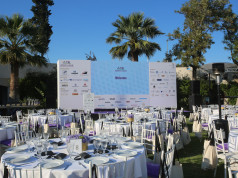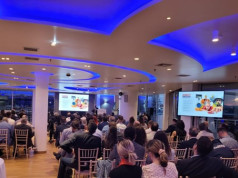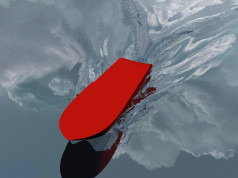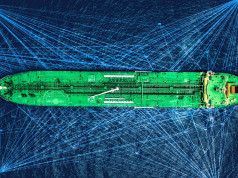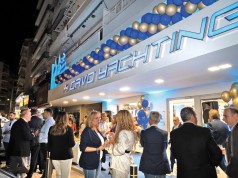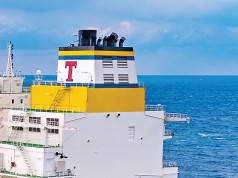The container ship AS Scotia already meets the
requirements of the Ship Energy Efficiency Management Plan (SEEMP),
which will become compulsory as of 1 January 2013. The SEEMP has been
adopted by the IMO as a mechanism for vessels to improve their
operational energy efficiency, thereby lowering CO2 emissions.
Ahrenkiel Shipmanagement was presented with a “Preliminary Energy
Efficiency Certificate” for the AS Scotia, the first issued to a GL
classed vessel. From 2013, all seagoing vessels larger than 400 gross
tonnage must carry on board a SEEMP, a management plan for the ship’s
energy efficiency, according to MARPOL, Annex VI.
Germanischer Lloyd has reviewed the content of the energy-efficiency
plan for the AS Scotia and has checked to see if it is on board. Captain
Christian Suhr, Managing Director of Ahrenkiel Shipmanagement, and
Wolfgang Kempke, Environmental Fleet Manager for Ahrenkiel
Shipmanagement, accepted the certificate from Kai Fock, Business
Development Manager for GL, and Dr Fabian Kock, Head of the
Environmental Certification Department at GL.
The “Preliminary Energy Efficiency Certificate”, which can be converted
into an International Energy Efficiency Certificate (IEEC) in 2013, was
issued by the German Flag State; the shipping company also received a
SEEMP Statement of Compliance from Germanischer Lloyd.
“Increasing the efficiency of our ships is a pillar of our climate
policy and a positive step – both in terms of the environment as well as
for the competitiveness of our fleet,” explains Christian Suhr. “That’s
why we decided early on to introduce the SEEMP and to share our
experience with classification societies and other shipping companies.
We view the awarding of the International Energy Efficiency Certificate
as confirmation of our environmental strategy.”
Some of the measures which have been used to improve the energy
efficiency of the AS Scotia include: a routing assistance system, speed
optimisation (super slow steaming), a modern coating for the ship’s
hull, the use of energy-saving lamps and a video training programme for
the crew on how to save energy.
“The AS Scotia has already fulfilled the requirements of the
International Energy Efficiency Certificate,” explained GL’s Kai Fock.
“The shipping company has also had GL review the content of the vessel’s
SEEMP. It conforms to the requirements laid out in the IMO guideline,
which we confirm by means of the certificate. The document itself was
checked as well as the responsibilities and the processes in the
management plan on site at the shipping company.”
As of 1 January 2013: SEEMP and EEDI
The International Maritime Organization (IMO) decided to adopt the SEEMP
as a requirement for both newly built and existing ships during its MEPC
62 environmental committee meeting in July 2011. The SEEMP brings a
number of measures together which can contribute to reducing fuel
consumption. The requirements of the SEEMP are set forth in resolution
MEPC.213(63): “2012 Guidelines for the Development of a Ship Energy
Efficiency Management Plan (SEEMP)”. A SEEMP and, for many types of
cargo ships with a building contract date after 1 January 2013, the
Energy Efficiency Design Index (EEDI), will be required to obtain the
new International Energy Efficiency Certificate (IEEC).
As the IEEC can first be issued on 1 January 2013, ship owners who
request certification to the new standards before this date are issued
with a “Preliminary Energy Efficiency Certificate” or “Energy Efficiency
Statement of Compliance”, which attests to compliance with the standard.
This preliminary certificate will be converted into a IEEC in 2013.
The SEEMP was adopted as part of Annex VI of the International
Convention for the Prevention of Pollution by Ships (MARPOL, Annex VI),
which primarily regulates ship air emissions. “This international
regulation calls for some 50,000 ships worldwide to be equipped with a
SEEMP by 1 January 2013 and for the management plan to be maintained on
board,” explains Kai Fock.
Figure 1: The presentation of the certificate (from left to right): Kai
Fock (GL), Christian Suhr (Ahrenkiel), Wolfgang Kempke (Ahrenkiel), Dr.
Fabian Kock (GL)
About Ahrenkiel
The Ahrenkiel-Group is an international consortium that is active in
ship-owning, ship management and financial services from its locations
in Hamburg (Germany), Berne (Switzerland) and Limassol (Cyprus). It is
also active internationally through other shareholdings and
partnerships. The Ahrenkiel Group has approximately 160 employees in
Hamburg. Worldwide it has approximately 200 land-based employees. Its
fleet in service currently comprises 52 ships with approximately 1,500
crew members.






